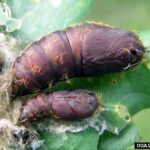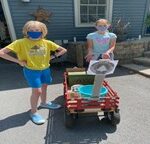Gypsy Moth Caterpillar Update June 16, 2021

This is a brief recap of the invasive gypsy moth and its caterpillar stages and its impact on our trees.
It is not too late to wrap trees in burlap or any breathable fabric. or with a combination of sticky tape with shiny tape top and bottom. Bridgehead is donating coffee bags (burlap) and as supplies arrive, I will send out an email to tell where they can be picked up. Some people are also spreading a one-to two-inch wide band of vegetable shortening and they are finding that the caterpillars will not cross it (this latter technique may be useful for trees that have deep bark indentations). At the end of the infestation, it will be necessary to wash the sticky tape and/or shortening off the tree with a detergent and water solution.




Prepare a pail of water with some dishwashing detergent― the detergent helps dissolve the wax that keeps the breathing holes on the caterpillar’s side from closing; water enters the caterpillar and it drowns. The caterpillars will crawl under the burlap at night.
We are asking people to adopt a tree or two. In parks or street trees, mark the burlap with your name or initials (so others know that you are returning to remove the caterpillars) and monitor it as often as possible.
When handling the caterpillars, wear gloves as the hairs carry a histamine that can provoke an allergic reaction similar to poison ivy. As the caterpillar goes from one instar to the next, the cast skins break down and the hairs are blowing around. So wear long-sleeved shirts and long pants and maybe even a hat when out walking or controlling the caterpillars. Seek medical attention if the blisters are severe.
The caterpillar poop (frass) sticks to the paint of cars so you may want to park in a sheltered place. Sweep up the frass and spread it on grass of a flower bed – it is fertilizer!
At this stage, the caterpillars are probably descending from the leaves at night and resting on the ground or at the base of the tree so checking your tree from 5 pm until dark and even after dark with a flashlight will net you a good haul of 2-3 inch caterpillars. Then check the tree again in the morning when it starts to warm up: 7:30-9 am is a good time. And, if you can, checking during the daytime also helps because the caterpillars will move around.
This moth has 5 stages of caterpillar growth (instars) if a male and 6 if female (she eats more to lay down fat to produce her 300+ eggs later this year).
We are about half- to three-quarters of the way through the caterpillars’ eating phases and as one caterpillar eats up to one square metre of leaf surface between hatching and pupating, it is important to continue monitoring our trees.
The caterpillars will start to pupate any time now from late June or early July; this is a good time to look for the brown hard-cased pupae and flick them into a pail of detergent and water along with any remaining live caterpillars. Check any surface: walls, tires, car wheel wells, eaves, undersurface of branches and especially the trunks of trees.


In the meantime, all is not lost for the defoliated trees. WATER YOUR TREES frequently but DO NOT add fertilizer to the water or sprinkle fertilizer around the tree. Leaf loss is a stress and combined with this spring drought, the impact is doubled. Fertilizer promotes new woody growth but you want leaves only. The tree has to ‘make a decision’ whether or not to use its starch reserves on new leaves and water helps promote re-leaf. The 2021 new leaves will be smaller and from the tree’s perspective, that is good. However, conifers, especially pines and spruces, may not survive because their reserves are in the needles which have now been eaten and they cannot replace the needles this year.
If it rains a bit more, a naturally-occurring fungus that multiplies in cool, wet weather will start attacking the caterpillars. A naturally-occurring virus may also show up.
Caterpillars hanging limply on the tree trunk head down or in a V-shape are being attacked by these diseases. This is normal and is to be celebrated by not removing the infected ones; nature’s biological control is in progress.
The adults will emerge from the pupal cases in August, mate (the adults fly in search of females, the females normally do not fly) and the female lays the eggs in a yellow soft and furry mass. At that point, we should begin the egg scraping and destruction process all over again.
Together, we can lessen the impact – so please keep up your good work and encourage others to join in (see picture below).
